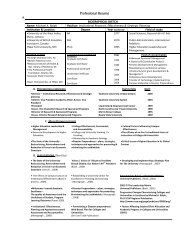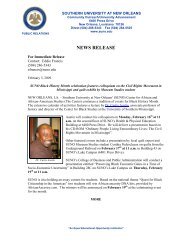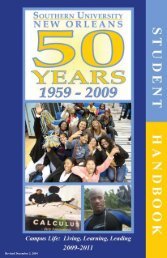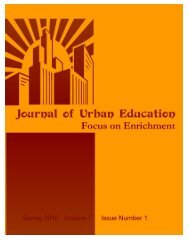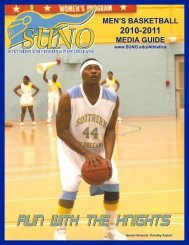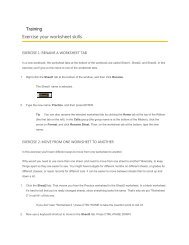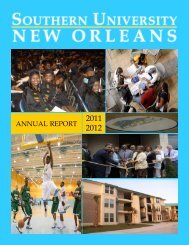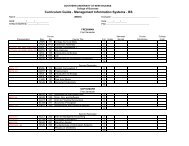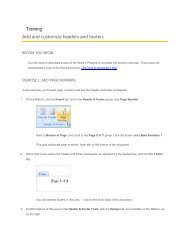Journal of - Southern University New Orleans
Journal of - Southern University New Orleans
Journal of - Southern University New Orleans
- No tags were found...
Create successful ePaper yourself
Turn your PDF publications into a flip-book with our unique Google optimized e-Paper software.
<strong>Journal</strong> <strong>of</strong> Urban Education: Focus on Enrichment 85that matched schools at each level that hadmade AYP with similar schools that had notmade AYP for four or more consecutiveyears. Studies with samples from urban districtsin other states and in different regions<strong>of</strong> the country would also contribute to ourgeneralizable knowledge <strong>of</strong> this phenomenon.REFERENCESAmerican Federation <strong>of</strong> Teachers (2005). AFT SalarySurveys, 2005 Survey & Analysis <strong>of</strong> TeacherSalary Trends. Retrieved August 16, 2007:http://www.aft.org /salary/.Ajzen, I., & Fishbein, M. (1969). The prediction <strong>of</strong>behavioral intentions in a choice situation.<strong>Journal</strong> <strong>of</strong> Experimental Social Psychology, 5, 400-416.Ajzen, I., & Fishbein, M. (1980). Understanding attitudesand predicting social behavior. EnglewoodCliffs, NJ: Prentice Hall.Ballone, L. M., & Czerniak, C. M. (2001). Teachers’beliefs about accommodating students’ learningstyles in science classes. Electronic <strong>Journal</strong><strong>of</strong> Science Education, 6(2), 1-41. Retrieved11/28/07 from: http://wolfweb.unr.edu/homepage/crowther/ejse/balloneetal.pdf.Bamberg, S., & Schmidt, P. (2001). Theory-driven,subgroup-specific evaluation <strong>of</strong> an interventionto reduce private car use. <strong>Journal</strong> <strong>of</strong> AppliedSocial Psychology, 31, 1300-1329.Bamberg, S., & Schmidt, P. (2003). Incentive, moralityor habit? Predicting students’ car use foruniversity routes with the models <strong>of</strong> Ajzen,Schwartz, and Triandis. Environment and Behavior,35, 1-22.Center on Educational Policy (2007, June). Answeringthe question that matters most: Has studentachievement increased since No ChildLeft Behind? Retrieved on June 13, 2007from:http://www.cep -dc.org/index.cfm? fuseaction=document.showDocumentByID&nodeID=1&Doc umentID=200.Clarke, M., Shore, A., Rhoades, K., Abrams. L.,Miao. J., & Lie, L. (2002). Perceived effects <strong>of</strong>state-mandated testing programs on teachingand learning: Findings from interviews witheducators in low-, medium-, and high-stakesstates. Boston: National Board on EducationalTesting and Public Policy. Boston College. RetrievedJune 15, 2007 from: http://www.bc.edu/research /nbetpp/reports.html.Epstein, J. L. (1995). School/family/ communitypartnerships: Caring for the children weshare. Phi Delta Kappan, 76, 701-712.Fishbein, M. (1963). An investigation <strong>of</strong> the relationshipsbetween beliefs about an object andthe attitude toward that object. Human Relations,16, 233-240.Fishbein, M. (1967). Attitude and the prediction <strong>of</strong>behavior. In M. Fishbein (Ed.), Readings in attitudetheory and measurement, (477-492). <strong>New</strong>York: Wiley.Fishbein, M. (1982). Social psychological analysis <strong>of</strong>smoking behavior. In J. R. Eiser (Ed.), Socialpsychology and behavioral medicine. <strong>New</strong> York:Wiley.Fishbein, M., & Ajzen, I. (1975). Belief, attitude, intention,and behavior: An introduction to theory andresearch. Reading, MA: Addison-Wesley.Fishbein, M., Higgins, D. L., Rietmeijer, C., & Wolitski,R. J. (1999). Community-level HIV interventionin five cities: Final outcome datafrom the CDC AIDS community demonstrationprojects. American <strong>Journal</strong> <strong>of</strong> Public Health,89, 336-345.Gersti-Pepin, C. I. & Woodside-Jiron, H. (2005).Tensions between the science <strong>of</strong> reading and alove <strong>of</strong> learning: one high-poverty school’sstruggle with NCLB. Equity and Excellence inEducation, 38, 232-241.Guisbond, L. & Neill, M. (2004, September/October).Failing our children: No Child Left Behindundermines quality and equity in education.The Clearing House, 12-16.Kim, H. (2003, April). Factors <strong>of</strong> forming teachers’ intentionto use the internet in class. Paper presentedat the meeting <strong>of</strong> the American EducationalResearch Association, Chicago.Lee, J. & Orfield, G. (2006, June). TrackingAchievement Gaps and Assessing the Impact<strong>of</strong> NCLB on the Gaps: An In-depth Look intoNational and State Reading and Math Outcomes.The Civil Rights Project. Harvard <strong>University</strong>.Retrieved on June 15, 2007 from http://www .civil rightsproject.harvard .edu/research /esea/nclb_naep_lee.pdf.



